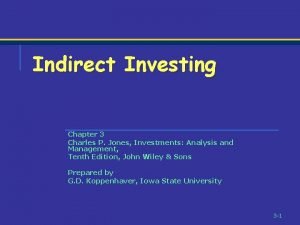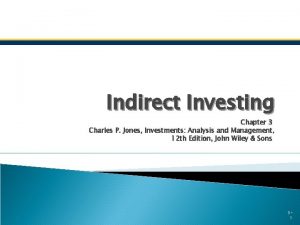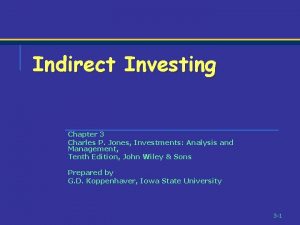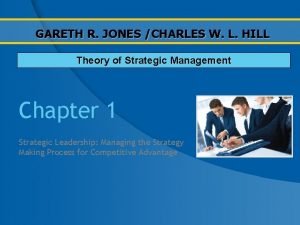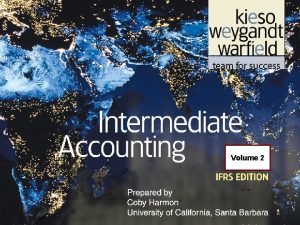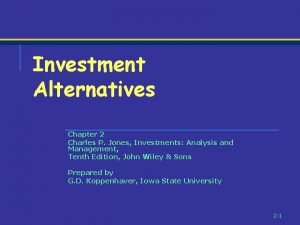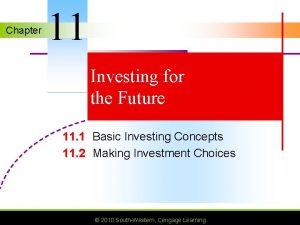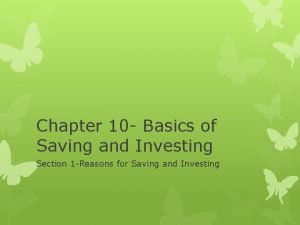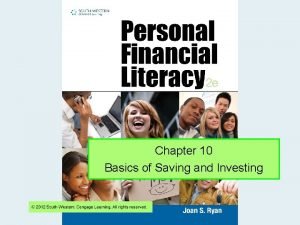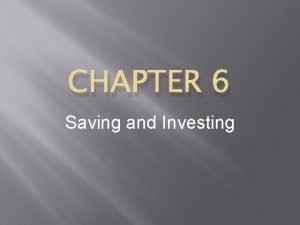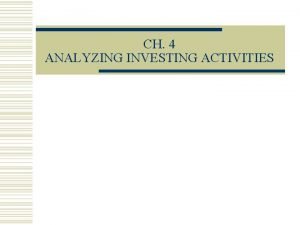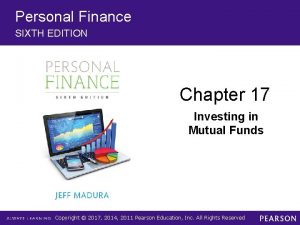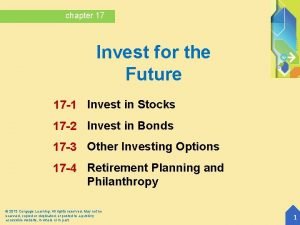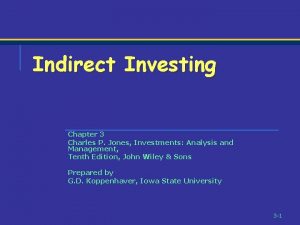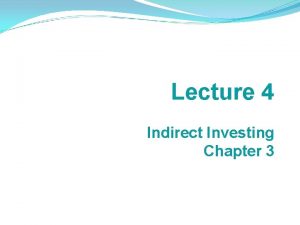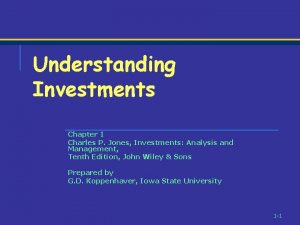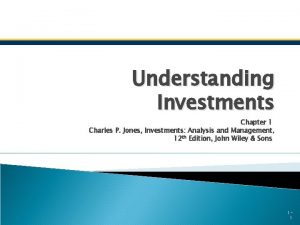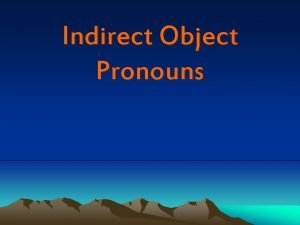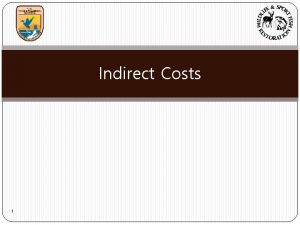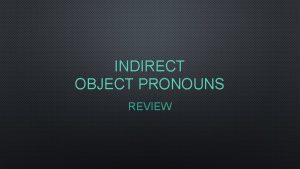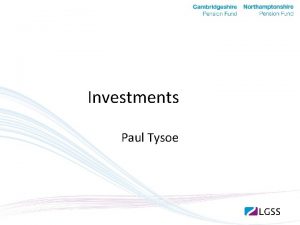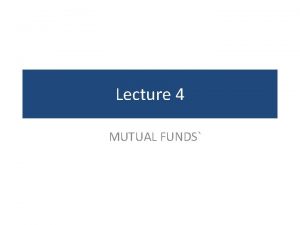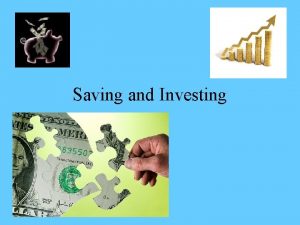Indirect Investing Chapter 3 Charles P Jones Investments















- Slides: 15

Indirect Investing Chapter 3 Charles P. Jones, Investments: Analysis and Management, Tenth Edition, John Wiley & Sons Prepared by G. D. Koppenhaver, Iowa State University 3 -1

Indirect Investing n n Alternative to direct investment in or ownership of securities Refers to buying and selling the shares of intermediaries that hold securities in portfolio Ø Ø Shares are ownership interest in portfolio entitled to portfolio income Shareholders also pay expenses 2

Investment Companies n Financial firm that sells shares to the public and uses the proceeds to invest in marketable securities Ø Ø Ø Acts as conduit for distribution of dividends, interest, and realized gains Can elect to pay no federal taxes on distributions Offers professional management 3

Company Types n Unit investment trusts: Typically holds an unmanaged, fixed-income portfolio Ø Ø Ø Assets not actively traded once purchased Trust ceases to exist when securities mature Passive investment 4

Company Types n Exchange Traded Funds: portfolio of assets that offer diversification over a sector, region, or market Ø Ø Ø Trade like individual equities on exchange Management fees low Investor controls realization of capital gains, losses n Ø Tax implications ETFs on equities, bonds, commodities 5

Company Types n Closed-end investment companies: No additional shares sold after initial public offering Ø Ø Share prices determined and trade in a secondary market Price may not equal Net Asset Value of the shares n Net Asset Value: Total market value of the security portfolio divided by total shares 6

Company Types n Open-end investment companies: Shares continue to be sold to the public at NAV after initial sale that capitalizes the company Ø Ø Ø Shares may be sold back to company at NAV Company size constantly changes Popularly called mutual funds 7

Mutual Fund Categories n Money market mutual funds invest in portfolio of money market securities Ø Ø Ø Taxable or tax-exempt Commercial paper important investment Average maturity limit: 90 days Investors pay a management fee but not a sales or redemption charge (load) Not insured by the federal government 8

Mutual Fund Categories n Equity, bond, and income mutual funds invest in portfolio of securities consistent with the objectives of the fund Ø Ø Ø Objectives set by the company’s board Disclosure of objectives to investors 18 major categories of investment objectives 9

Equity Funds n n Most assets in equity funds rather than bond or income funds Most equity funds are either: Ø Ø Value funds, which invest in undervalued stocks as determined by fundamental financial analysis Growth funds, which invest in stocks of firms expected to show future rapid earnings growth 10

Cost Considerations n Closed-end fund prices may be at a discount or premium to NAV Ø n Liquidation value different than price “Load” funds charge a front-end fee to cover the costs of selling the fund to investors Ø May also be a redemption (back-end) fee or distribution fee (called 12 b-1 fee) 11

Cost Considerations n n All fees must be stated in the mutual fund prospectus No-load funds are purchased at NAV directly from the investment company Ø Ø Ø No sales force expense to cover Investors must seek out funds Still an annual operating expense paid out of fund income 12

Performance n n Reported on a regular basis in the popular press Measured over a given time period as a percent of initial investment Ø Ø Total returns include reinvested dividends and capital gains Average annual return reflects the mean compound growth rate of investment over a given time period 13

International Funds n Some mutual funds specialize in international securities Ø Ø Ø US investors can participate in emerging market economies International funds or global funds emphasize international stocks Single-country funds concentrate assets n Actively or passively managed 14

New Directions n Mutual fund “supermarkets” Ø Ø Ø n Various mutual fund families can be purchased through a single source Brokerage account may provide access “Supermarket” managers earn fee Hedge Funds Ø Largely unregulated investment companies available to private investors n n May use leverage, strategies not available to mutual fund managers Substantial initial investment required 15
 Indirect investing
Indirect investing Indirect investing
Indirect investing What is indirect investing
What is indirect investing Charles w. l. hill y gareth jones
Charles w. l. hill y gareth jones Charles manson charles luther manson
Charles manson charles luther manson Intermediate accounting chapter 17 investments pdf
Intermediate accounting chapter 17 investments pdf Under ifrs the presumption is that equity investments are
Under ifrs the presumption is that equity investments are Chapter 2 investments
Chapter 2 investments Chapter 11 real estate and other investments
Chapter 11 real estate and other investments The spreading of risk among many types of investments
The spreading of risk among many types of investments Chapter 10 basics of saving and investing
Chapter 10 basics of saving and investing Holding a variety of investments to reduce risk
Holding a variety of investments to reduce risk Chapter 6 saving and investing
Chapter 6 saving and investing Chapter 4 analyzing investing activities solutions
Chapter 4 analyzing investing activities solutions Chapter 17 investing in stocks
Chapter 17 investing in stocks Chapter 17 investing in stocks
Chapter 17 investing in stocks
